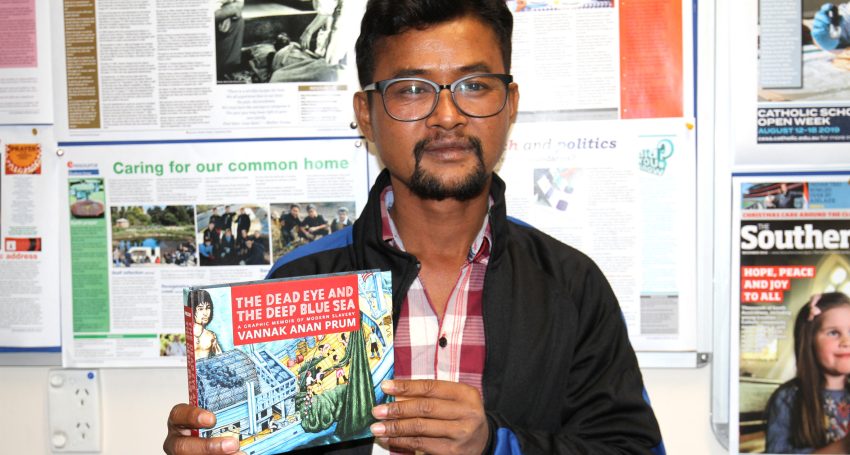Reflections of a modern day slave
People
As a young boy growing up in Cambodia, Vannak Anan Prum loved drawing in the dirt with a stick, his artistic talent clearly evident to those in his small village. Little did he realise that decades later he would use his skills as an illustrator to send an important message to the world about the scourge of modern-day slavery.

When Vannak Anan Prum decided to venture from his home country of Cambodia to Thailand in search of work, he had little idea of what horrors lay ahead of him.
He and his wife were expecting their first child and Vannak wanted to make sure they had enough money for her hospital visit. It never crossed his mind that his planned two-month absence would in fact last five terrible years, that he would miss seeing the birth of his daughter, and that he would join thousands of men working as slaves in the Asian fishing industry.
Advertisement
But that is exactly what happened. Lured by human traffickers and the promise of a big pay check, Vannak was taken from the Thai border to join a fishing crew. He was transported by a large supply ship to one of the many fishing vessels working in international waters off Thailand’s coast.
Cut off from the world, the slaves spend years working on the boats, never seeing land and working under duress. They are not paid, work long hours with little sleep and if they become ill face the prospect of being thrown overboard.
Vannak’s personal horror working on a fishing vessel lasted three years and seven months and ended only when he jumped from the ship and swam for his life. Unfortunately, when he finally reached land he was rescued by men who then sold him as a slave to a plantation owner in Malaysia.
Another year of hard labour and imprisonment followed until a human rights organisation helped him to finally return to his family (which now also includes a son).
Back in his village, Vannak has spent the past few years drawing pictures that tell his story. The result is his memoir, The Dead Eye and the Deep Blue Sea – a graphic recount of his time as a slave and the horrendous conditions he endured.
“When I tell my story or people read my book they find it very interesting. Some people have known some things about the issue (of modern slavery) but not all the things,” Vannak, 41, told The Southern Cross via an interpreter during a visit to Adelaide last month.
“I am a Buddhist and that faith did help me on the boat and gave me strength. I always thought I would get back to my family and that I would return. I never gave up hope.”
He said he felt compelled to share his story so that everyone could understand that human trafficking and slavery are alive and thriving today.
Accompanying Vannak on his visit was filmmaker Jocelyn Pederick, who has lived in Cambodia for the past 13 years. Together with her brother Ben, Jocelyn runs Goodmorningbeautiful Films and in 2011 they were commissioned to produce a series of short films on human trafficking in Asia, focusing on the fishing industry.
Advertisement
It was through this project she was put in contact with “an incredible artist with an amazing story”.
“Vannak draws all the time when you talk to him and when I first met him we talked for hours. I said at the end, you should make a book, this would be an amazing book and he said, ‘I know’.
“He always had that idea that he was going to come back and share his story, he always thought that was important.
“It’s his mission to tell everyone his story so it serves as a precautionary tale for other people,” Jocelyn explained, adding that she and Ben were now working on adapting the book into an animated film.
In her introduction in the book, Human Rights Watch director of Global Initiatives, Minky Worden, describes modern slavery in Asia’s fishing industry as “rampant and notorious”.
“The boats operate in international waters, outside of the reach of law and monitoring. Years can pass without any opportunity to escape forced labour on the fishing vessels. And escape is not a certainty,” she writes.
When the South Korean trawler Oyang 70 sunk about 200 nautical miles off Dunedin, New Zealand in 2010, the working conditions aboard these vessels were laid bare for the world to see.
“What emerged was a horrific picture of floating fish-processing prisons. Human life on these boats is worth less than the tons of seafood that workers pull from the ocean. The fishermen toil seven days a week, morning to night, year after year. Many do not see land for years,” Worden explained.
Vannak’s visit to Australia was hosted by the Anti-Slavery Taskforce of the Catholic Archdiocese of Sydney, which invited him to tell his story at an anti-slavery conference attended by representatives from more than 40 Catholic organisations. The visit also doubled as a promotional tour for his book and while in Adelaide he addressed a gathering at Pilgrim Uniting Church.
The Dead Eye and the Deep Blue Sea is published by Seven Stories Press and distributed in Australia through Penguin Random House, and available through all good bookshops or online retailers.








Comments
Show comments Hide comments